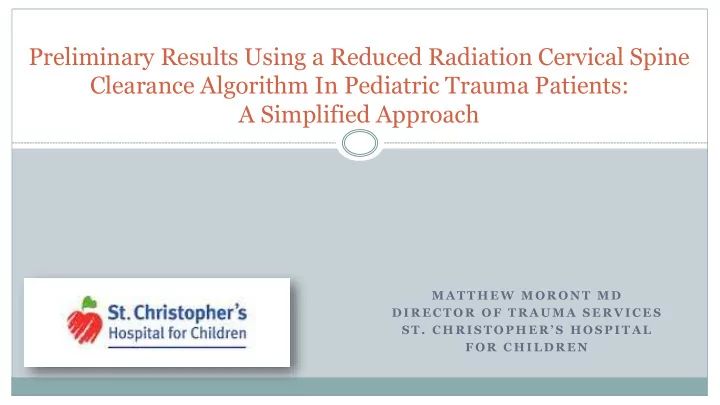

Preliminary Results Using a Reduced Radiation Cervical Spine Clearance Algorithm In Pediatric Trauma Patients: A Simplified Approach M A T T H E W M O R O N T M D D I R E C T O R O F T R A U M A S E R V I C E S S T . C H R I S T O P H E R ’ S H O S P I T A L F O R C H I L D R E N
NO DISCLOSURES
Introduction Cervical spine injuries uncommon 1-2% incidence Devastating consequences Death Paralysis Treatment of cervical spine injuries begins with cervical spine clearance Efficient and safe clearance of the uninjured patient Limit radiation exposure Identification of injured patients
Care of Pediatric Cervical Spine Injury is Clinically Challenging for the Trauma Team Limited experience Orthopedic surgery Neurosurgery Trauma Surgery Emergency Medicine Radiology First responders Complex problem Poly-traumatized child
Pediatric Cervical Spine Clearance Protocols NO Consensus J Trauma, 2009 • Trauma Surgery and Neurosurgery literature • Awake child vs obtunded child • Radiographs vs CT • Standardized protocol J Trauma, 2011
Pediatric Cervical Spine Study Group Cervical Spine Clearance Survey 25 Pediatric Trauma Centers ONLY 46% had NO consensus Primary team responsible for cervical spine clearance Imaging modalities used clearance protocol
Radiation Exposure Ionizing radiation Increases life-long cancer risk Breast/thyroid most sensitive
Institutional Objectives NEED for Improvement Develop a clinical C-spine clearance algorithm which reflected current best practice Reduce radiation exposure without increasing missed injury rate Consistency among providers Emergency medicine Trauma Orthopedics Neurosurgery Radiology
2011 C-Spine Clearance Algorithm
ALGORITHM FOR EVALUATION OF THE TRAUMA PATIENT FOR CERVICAL SPINE INJURY GCS ≤ 12 Reliable History and Abnormal Exam OR Physical History or Age < 5 Normal Exam and Leave in C-Collar Physical obtain AP and Lateral C-Spine Xrays Yes No Positive Obtain C-Spine No findings Clear C-Spine finding on Xray on Xray Xray Re-evaluate in 24 hours Consult Spine Service Normal Abnormal Persistent Clear No Neck Pain C-Spine Unreliable Exam Yes Continue C- Re-Evaluate Collar Reliable Exam
What Was Different? More frequent Emergency Department re-evaluation Next day re-evaluation Trauma Surgery Increased involvement of the Spine Service Neurosurgery Orthopedics
Materials and Methods Inclusion Criteria Data Points < 18 y of age Age All patients with trauma mechanism MOI suspicious for cervical spine injury ISS Emergency Medicine GCS on arrival Trauma Service Imaging studies Exclusion Criteria CT findings All deaths Time to collar removal All patients with cervical spine CT from Discharged in collar outside facility Who cleared C-spine 3 study periods Spine Service Study Group 1 2011 Length of stay Study Group 2 2012-13 C-spine injuries Study Group 3 2014 Missed/delayed diagnosis
Study Population • Study 259 Group 1 • 2011 • Study Required Group 2 Trauma 3632 762 360 C-Spine Contacts • 2012 & Clearance 2013 • Study 143 Group 3 • 2014
Study Group Demographics • Male • Female 68.4% 31.1% (521) (237) 28% 72% (213) (549) • <= 5 • > 5 years years old old Mean age 8.8 years
Study Population GCS ISS 15 91% (694) Mild (1-8) 85% (646) 8-14 7.6% (58) Moderate (9-16) 13% (99) <8 1.3% (10) Severe (>16) 2% (17)
Sub-Group Analysis SG1 SG2 SG3 Number of CT’s 90%% (233) 42.2% (152) 28.7% (41) p=<0.0001 LOS 2.51 2.45 2.27 Clearance By Emergency Medicine 44% (96) 25% (76) 28% (34) Surgery 44% (97) 46% (141) 48% (58) Spine Service 12% (27) 29% (90) 24% (29) Discharged in Collar = 113
Time to Clearance SG1 SG2 SG3 < 13 hours 91% (197) 76% (232) 79% (97) 13-24 hours 8% (18) 22% (69) 19% (23) > 24 hours 1% (2) 2% (5) 2% (2) Discharged in Collar = 113
Study Limitations PILOT study Small numbers Incomplete statistical analysis Retrospective study Historical control
Conclusions The increased involvement of the Spine Service in C-spine clearance and NEXT day re-evaluation by the trauma team: An increase time to C-spine Clearance in the 13-24 hr time period No increase in LOS A significant reduction in the use of CT to obtain C-spine clearance with no increase in missed injury rate
Thank You Selected References Eubanks J, Gilmore A, Bess S, Cooperman D: Clearing the Pediatric Cervical Spine Following Injury.Journal of the American Academy of Orthopedic Surgeons 2006;14:552-64. Hannon M, Mannix R, Dorney K, Mooney D, Hennelly K. Pediatric Cervical Spine Injury Evaluation After Blunt Trauma: A Clinical Decision Analysis. Ann Emerg Med. 2014 Oct 16. pii: S0196-0644(14)01259-1.(Epub ahead of print). Henry M, Scarlata K, Riesenburger RI, Kryzanski J, Rideout L, Samdani A, Jea A, Hwang SW: Utility of STIR MRI in Pediatric Cervical Spine Clearance after Trauma. Journal of Neurosurgery: Pediatrics 2013;12(1):1333-338 Jones TM, Anderson PA, Noonan KJ: Pediatric Cervical Spine Trauma. Journal of the American Academy of Orthopedic Surgeons 2011;19:600-11. Kreykes NS, Letton, Jr RW: Current Issues in the Diagnosis of Pediatric Cervical Spine Injury. Seminars in Pediatric Surgery 2010;19:257-64. Leonard JR, Jaffe DM, Kuppermann N, Olsen CS, Leonard JC; Pediatric Emergency Care Applied Research Network (PECARN) Cervical Spine Study Group. Cervical spine injury patterns in children. Pediatrics. 2014 May;133(5):e1179-88. doi: 10.1542/peds.2013-3505. Puisto V, Kaarianen S, Impinen A, et al: Incidence of spinal and spinal cord injuries and their surgical treatment in children and adolescents: A population based study. Spine (Phila 1976). 2010;35:104-107. Sun R, Skeete D, Wetjen K, Lilienthal M, Liao J, Madsen M, Lancaster G, Shilyansky J, Choi K. A pediatric cervical spine clearance protocol to reduce radiation exposure in children. J Surg Res. 2013 Jul;183(1):341-6. (Epub 2013 Jan 16). Vanderhave K, Chiravuri S, Caird M, Farley F, Graziano G, Hensinger R, Patel R: Cervical Spine Trauma in Children and Adults: Perioperative Considerations. Journal of the American Academy of Orthopedic Surgeons 2011;19:319-27.
Recommend
More recommend